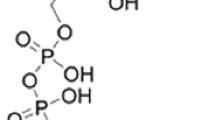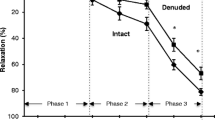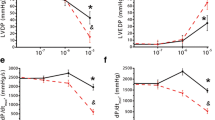Summary
We investigated the negative chronotropic and vasodilating properties of new selective A1 and A2 adenosine agonists such as 2-chloro-N6-cyclopentyladenosine (CCPA) and 2-hexynyl-5′-N-ethyl-carboxamidoadenosine (2-hexynyl-NECA) as compared with reference adenosine analogues. The potency of these compounds on heart rate was assessed in the rat atrial preparation and their activity on the vascular tone was determined in both rat aorta and bovine coronary artery. CCPA was found to be the most potent At agonist of those currently available in producing negative chronotropic effects (EC50 = 8.2 nM). The A1 antagonist 8-cyclopentyl-1,3-dipropyl-xanthine (DPCPX) blocked CCPA activity in a dose-dependent manner. There was also a significant correlation between its biological effect and the affinity for A1 receptors as measured in the rat brain by [3H]-N6-cyclohexyladenosine (3[H]-CHA) binding. The A2 selective agonist 2-hexynyl-NECA showed vasodilating properties comparable with those observed with the reference compounds, CGS 21680 and NECA. EC50 values were 596 and 569 nM in rat aorta and bovine coronary artery, respectively. Moreover, the rank order of potency was similar in the two vascular districts examined, suggesting that the rat aorta is a useful model for studying the effects of adenosine derivatives on vascular tone. In addition, the potency of the compounds in inducing vasodilation was found to be correlated with their affinity for A2 receptors as measured in the rat striatum by 3[H]-CGS 21680 binding.
These data further support that A1 receptors are involved in depressing cardiac activity and A2 receptors in inducing vasorelaxation.
Similar content being viewed by others
References
Balwierczak JL, Krulan RSCM, Field FP, Weiss GB, Miller MJS (1991) Comparative effects of a selective adenosine A2 receptor agonist, CGS 21680, and nitroprusside in vascular smooth muscle. Eur J Pharmacol 196:117–123
Brown C, Brunstock G, Cusack NJ, Meghji P, Moody CJ (1982) Evidence for stereospecificity of the P1-purinoceptor. Br J Pharmacol 75:101–107
Bruns RF, Daly JW, Snyder SH (1980) Adenosine receptors in brain membranes: binding of N 6-cyclohexyl-[3H]adenosine and 1,3-diethyl-8[3H]phenylxanthine. Proc Natl Acad Sci USA 77:5547–5551
Cheng YC, Prusoff HR (1973) Relationship between the inhibition constant (Ki) and the concentration of inhibitor which causes 50% inhibition (IC50) of an enzymatic reaction. Biochem Pharmacol 22:3099–3108
Collis MG (1983) Evidence for A1-adenosine receptors in the guinea-pig atrium. Br J Pharmacol 78:207–212
Collis MG (1991) Adenosine receptors in isolated tissue preparations. Nucleos Nucleot 10:1057–1066
Cristalli G, Eleuteri A, Vittori S, Volpini R, Lohse MJ, Klotz K (1992) 2-Alkynyl derivatives of adenosine and N-ethyladenosine-5′-uronamide as selective agonists at A2 adenosine receptors. J Med Chem 35:2363–2368
Dionisotti S, Zocchi C, Varani K, Borea PA, Ongini E (1992) Effects of adenosine derivatives on human and rabbit platelet aggregation. Correlation of adenosine receptor affinities and antiaggregatory activity. Naunyn-Schmiedeberg's Arch Pharmacol 346:673–676
Finney DJ (1978) Statistical methods in biological assays, 3rd edn. Griffin, London, pp 80–82
Haleen SJ, Steffen RP, Hamilton HW (1987) PD 116,948 a highly selective A1 adenosine receptor antagonist. Life Sci 40:555–561
Jacobson KA, Van Galen PJ, Williams M (1992) Adenosine receptors: pharmacology, structure-activity relationship and therapeutic potential. J Med Chem 35:407–422
Jarvis MF, Schultz R, Hutchinson AJ, Do UH, Sills MA, Williams M (1989) [3H]CGS 21680, a selective A2 adenosine receptor agonist directly labels A2 receptors in rat brain. J Pharmacol Exp Ther 251:888–893
King AD, Milavec-Krizman M, Muller-Schweinitzer E (1990) Characterization of the adenosine receptor in porcine coronary artery. Br J Pharmacol 100:483–486
Lohse MJ, Klotz KN, Schwabe U, Cristalli G, Vittori S, Grifantini M (1988) 2-Chloro-N6-cyclopentyl-adenosine: A highly selective agonist at A1 adenosine receptors. Naunyn-Schmiedeberg's Arch Pharmacol 337:687–689
Makujina SR, Sabouni MH, Bhatia S, Douglas FL, Mustafa SJ (1992) Vasodilatory effects of adenosine A2 receptor agonists CGS 21680 and CGS 22492 in human vasculature. Eur J Pharmacol 221: 243–247
Merkel LA, Lappe RW, Rivera LM, Cox BF, Perrone MH (1991) Demonstration of vasorelaxant activity with an A1-selective adenosine agonist in procine coronary artery: involvement of potassium channels. J Pharmacol Exp Ther 260:437–443
Mustafà SJ, Askar AO (1985) Evidence suggesting an Ra-type adenosine receptor in bovine coronary arteries. J Pharmacol Exp Ther 232:49–56
Oei HH, Ghai GR, Zoganas HC, Stone GA, Zimmerman MB, Field FP, Williams M (1988) Correlation between binding affinities for brain A1 and A2 receptors of adenosine agonists and antagonists and their effects on heart rate and coronary vascular tone. J Pharmacol Exp Ther 247:882–888
Ramagopal M, Chitwood RW, Mustafa SJ (1988) Evidence for an A2 adenosine receptor in human coronary artery. Eur J Pharmacol 151:483–486
Sabouni MH, Cushing DJ, Mustafa SJ (1989) Adenosine receptor-mediated relaxation in coronary artery: evidence for a guanyl nucleotide-binding regulatory protein involvement. J Pharmacol Exp Ther 251:943–948
SAS Institute Inc (1987) SAS/STAT Guide for Personal computers, 6th edn. Cary, NC. SAS Institute Inc, pp 549–640
Snedecor GW, Cochran WG (1967) Statistical methods, 6th edn. The Iowa State University Press, Ames, Iowa
Stogall SM, Shaw J (1990) The coexistence of adenosine A1 and A2 receptors in guinea-pig aorta. Eur J Pharmacol 190:329–335
Author information
Authors and Affiliations
Additional information
Correspondence to A. Conti at the above address
Rights and permissions
About this article
Cite this article
Conti, A., Monopoli, A., Gamba, M. et al. Effects of selective A1 and A2 adenosine receptor agonists on cardiovascular tissues. Naunyn-Schmiedeberg's Arch Pharmacol 348, 108–112 (1993). https://doi.org/10.1007/BF00168545
Received:
Accepted:
Issue Date:
DOI: https://doi.org/10.1007/BF00168545




